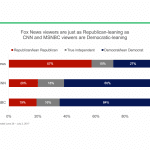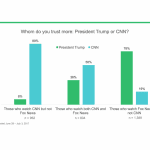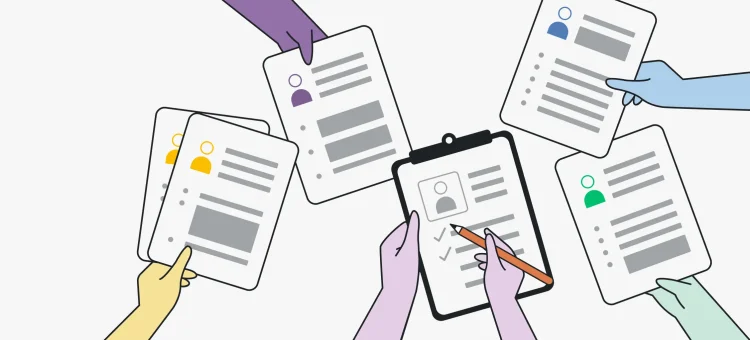True, the majority (57 percent) of their audience identifies as Republican or GOP-leaning, and nearly the same percentage (56%) say they voted for Donald Trump in the 2016 general election.
But as right-leaning as Fox’s audience is, viewers of both MSNBC and CNN are equally or more left-leaning, with 60 percent of CNN viewers and 64 percent of MSNBC viewers identifying as Democrats or leaning toward the Democratic Party. When asked about last year’s election, 59 percent of MSNBC viewers say they voted for Hillary Clinton, as did 54 percent of CNN viewers. Only about one in five Fox News viewers said they voted for Clinton, with a similarly low proportion of CNN and MSNBC viewers voting for Trump.

These data highlight the partisanship that divides the media giants, both in the way they are perceived by viewers and the number of viewers who actually tune in to their programs. When President Trump criticizes CNN or the New York Times or the Washington Post for being “fake news,” he is touching on a very real partisan divide. These media outlets rely on the trust of their audiences—that’s how they make money, after all. As it turns out, though, that trust is built as much on partisanship as on truth-telling.
When asked whether they trust President Trump or CNN more, 74 percent of CNN viewers chose CNN—but 61 percent of Fox viewers said they trust President Trump more than CNN. There’s no such thing as trust in the media as a collective unit; instead, it’s every news organization for itself.
In some ways, this is still surprising. For one, there is significant overlap in viewership among these partisan-leaning cable channels. A quarter (25 percent) of Fox News viewers also regularly watch MSNBC, and an even larger proportion (41 percent) also watch CNN.
As you might expect, those who watch one channel or the other (or both) have widely varying degrees of trust in each media outlet. Of those who watch CNN but not Fox News, 89 percent trust CNN more than Trump; of those who watch Fox News but not CNN, 78 percent trust Trump more than CNN. Opinions are more divided among those who watch both cable channels: 58 percent trust CNN more than Trump.

Even with this ideological divide, no other media outlets that we asked about come close to reaching the same degree of audience overlap with Fox News. Just 12 percent of Fox viewers say they read Breitbart, the right-wing website formerly run by Trump advisor Steven Bannon, and 10 percent say they read the Drudge Report, which made a name for itself exposing President Clinton’s scandals in the 1990s.
These websites are the real bastion of Trump support in the media. Large (yuge?) majorities of their audience are Trump supporters; 81 percent of Breitbart readers and 81 percent of Drudge readers say they voted for Trump. But their bases, in raw numbers, are relatively small. Some 12% of Republicans say they regularly read Breitbart and 10% say they read the Drudge Report—though that’s more than get their news from NPR, the New York Times, and the Washington Post (all 6% among Republicans).
What’s really impressive is just how large of an audience Fox has. As the president might say, many, many people watch Fox News. They love it. They love Fox News. In fact, 43% of adults tell us they tune in to Fox News on a “daily or almost daily” basis. For comparison, CNN can count 36% of the country as its viewers, and MSNBC trails with 23%.
What’s more, Fox viewers get less of their news from other sources. Of the 10 media outlets we listed (CNN, Fox News, MSNBC, Buzzfeed, Breitbart, the Drudge Report, NPR, the New York Times, the Washington Post, and the Wall Street Journal), Fox viewers said they get their news from an average of 2.6 of them. CNN and MSNBC viewers showed more signs of diversity, reporting getting news from an average of 3.5 and 4.0 news sources, respectively.
President Trump and Fox News are the best of friends on social media. They send each other supportive messages, and they promote each other on Twitter. But Fox News viewers are only as supportive of Trump as CNN and MSNBC viewers were supportive of Hillary Clinton—and that support was not enough for her to win the election.
Methodology: This SurveyMonkey Tracking poll was conducted online June 29 through July 3, 2017 among a national sample of 4,965 adults ages 18 and up. Respondents for this survey were selected from the nearly 3 million people who take surveys on the SurveyMonkey platform each day. Data for this week have been weighted for age, race, sex, education, and geography using the Census Bureau’s American Community Survey to reflect the demographic composition of the United States.



